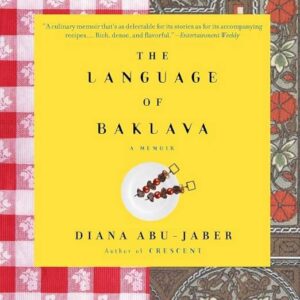In Diana Abu-Jaber’s memoir, “The Language of Baklava,” food represents something more substantial than savory, delectable provisions. It embodies “grace, difference, faith, love.” It is a ritual of remembrance and an edible keepsake for memories. As Diana and her family move between upstate New York and Jordan, food relieves them of the bitter flavor of homesickness and its accompanying isolation. The memoir contains 24 chapters, interspersed with mouthwatering family recipes that travel the reader through Diana’s critical life memories. A meal stands at the heart of each story as she recounts family feasts, dinner parties, and outdoor picnics. This memoir captures food’s power to preserve the past and define the identity of an Arab American with a craving for two cultures.
Like most adolescent girls, Diana was stubborn and defiant. She would spend nights behind the screen of rose beads concealing her bedroom doorway, drafting stories about characters escaping their overbearing parents. Her proudest literary work involved a man who created a pair of wings using beer pull tabs and flew away from his oppressive household. Although fictional, Diana’s written creations bore uncanny similarities to her life experiences. She is the eldest child of a Jordanian father, a U.S. immigrant known intimately as Bud, who embraces an excessive fondness for food, cooking, and storytelling. He shares Diana’s stubborn personality. The two frequently fall into heated debates where Bud protests Diana’s too-Americanized way of life, and Diana criticizes Bud’s incapacity to empathize. Yet, in the shadow of every spirited bickering is a heartfelt meal that washes away the anger and frustrations—sizzling pieces of shish kabob, the most tender okra stew, a velvety layered dish of bread, chicken, pine nuts, and yogurt.
Some meals remain tied to particular moments, and this is especially true for mensaf. Diana resided in Jordan for a period of her childhood, where she would spend her days in the Jordanian sandy air, running across the courtyard with her neighbors among the “big, nodding sunflowers, and marigolds, and mint plants” (p. 32). While in Jordan, she traveled to the desert to visit her Bedouin family. They laughed and conversed and, when it came time, gathered around to watch as three men poured the contents of a cooking pot onto an expansive serving platter: “The great pouring of the mensaf” (p. 65). Diana devoured the smooth mixture of lamb, rice, bread, and sauce, its scalding heat stinging her mouth and tongue. She savors this moment of pure community and utter serenity. Although unrealized to her at the time, it will become a sacred memory she cannot recreate upon her impending return to the United States.
Other meals translate to untraditional languages of love. During one of her few visits, Auntie Aya, Bud’s family matriarch, suggested she and Diana bake. The teen girl complied, “as long as it isn’t Arabic [food]” (p. 185). To Diana’s surprise, Aya shared her niece’s distaste for the region’s cuisine. The two consequently set out to make the Greek baklava, which Auntie Aya stressed should not be confused with the Arab baklawa. Although there are no differences between the two sweets, both sharing the same flaky crust and core of sweet, roasted pistachios, Diana and Aya’s language choice is critical and indicative. The Greek baklava holds no apparent cultural ties to her paternal heritage. Auntie Aya’s visit coincided with one of Bud’s seemingly endless feuds with his daughter. Diana’s aversion to Arab food exemplifies her attempt to strain her connection to her Arab heritage, a critical piece of her identity. Her dislike for the cultural cuisine is a subtle effort to reject her ties to her father by refusing the element of Arab culture he holds dearest, food. However, the baklava turned out to be an unprecedented peace offering. Its sweet, promising aromas of “time, loss, and grief” inspired a truce between Bud and Diana. The language of baklava is thus manifold, from baklawa, its literal translation to Arabic, to the complex love language between a father and daughter.
“The Language of Baklava” is a lighthearted memoir that details pivotal moments in Diana’s humorous life through the magic of food. Diana navigates through cultural differences and grievances, capturing a glimpse into a father’s story through his daughter’s eyes. Their relationship is bumpy, complex, loving, and comforting all at once. Diana Abu-Jabber’s food memoir will leave you craving its featured recipes and more of her radiant prose.
Discussion Questions:
- On page 189, Aunt Aya claims: “People say food is a way to remember the past. Never mind about that. Food is a way to forget.” Do you agree with this sentiment? Why or why not?
- How does food help Diana Abu-Jabber and her family navigate through the sense of rootlessness that comes with frequent relocation?
- Think back at your culture/family life. What role, if any, does food play? Has food ever helped you connect with an aspect of your identity?
- How does Diana’s fondness for particular foods correspond with her relationship with her culture and family?
- Try one of the recipes Diana Abu-Jabber features in “The Language of Baklava”!


